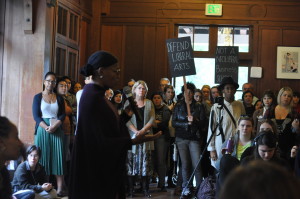Students of color have expressed feelings that the dialogues surrounding the proposed curriculum lack an essential element important to making decisions on campus: diversity.
Since President Alecia DeCoudreaux’s Oct. 19 memo went out, multiple open forums have been hosted for all of campus to take part in the discussions around why the proposals were made in the first place. It has been stated on social media and elsewhere that because the departments of dance and book art do not have a may students of color enrolled in the programs students of color do not feel included in this fight.
In addition to students of color not feeling included in these discussions, there is also a feeling that the Mills community is showing more outrage over these proposals than they did during 2014 when a racist threat was made against Black people on campus.
Interim Provost Sharon Washington acknowledged that she and the administration are aware of the conversations happening on campus about the inequities students of color have brought up. She also talked about how the conversations are not just centered around the proposed budget cuts.
“I am aware that students had feelings that departments and the campus had issues of racism, transphobia and classism playing out across campus,” Washington said.
Rachel Patterson, President of Associated Students of Mills College, says she finds there to be problems surrounding accessibility for students, not just in the programs proposed to be cut, but also in the meetings and community forums being held for students. Patterson was unsurprised and glad that the issues of access in arts programs were being addressed by programs.
“It’s more than just students of color, it’s also low-income students,” Patterson said. “There’s all kinds of barriers between [the book art and dance] departments and student access, so that is something we have to think about if we keep those departments.”
According to Patterson, she tried to express to the administration in charge of making the student meetings that they should schedule open meetings at different times on various days. Instead the administration opted to hold two open meetings one week apart, both at the same time on the same weekday. The first of these open meetings, Patterson noted, were attended by primarily white students from the book art department.
“Then a meeting followed that was exactly at the same time, which means that all of the same students who already had access to be able to come were coming,” Patterson said. “That creates issues for students, like myself, who have to work at lunchtime or have other obligations and responsibilities.”
While the lack of students of color in dance and book art is something being brought up, students speaking about the inequities in the department note other issues as well. Nazanin Szanto, who prefers the pronouns they/them, has been bringing up the topics of inequities in book art and dance on many media platforms. Szanto, along with fellow student Ariana Cruz-Sellu, penned an opinion piece for The Campanil to address the proposals after the initial announcement. In this opinion piece they stated that some of the inequities they found in the departments included racism, classism, elitism, fatphobia and transphobia.
Szanto states that they are making themselves known on campus as a person other students of color can go to voice concerns about the departments that are being proposed to be cut.
One of the most specific instances that students of color have taken issue with the dance department is the controversy of classes surrounding cultural forms of dance. Many of these classes, including a belly-dancing class and a hip hop class, are taught by white professors, causing students of color to say the classes were culturally appropriative.
Szanto said that they have been approached by students who have taken classes in the dance department and felt they were unable to bring up these issues of cultural appropriation and intersectionality.
“Because of that I feel like students of color aren’t going to want to take dance classes because if you try to bring in intersectionality or talk about cultural appropriation and you’re met with a lot of resistance, it doesn’t make it feel like it’s a healthy learning environment,” Szanto said.
However, dance and child development major Nia Fitzpatrick, who prefers the pronoun they/them, refutes that. They are taking a leadership role in the department to make sure dance is not marginalized on campus, and they say there is an issue of cultural transmission being mistaken for cultural appropriation.
“That’s a broad spectrum, and the question of when does cultural transmission become cultural appropriation is a huge discussion topic,” Fitzpatrick said. “I think that we need to expand that conversation so that it’s an interdepartmental conversation, and I think that we need more credit in the dance department for the fact that we do talk about these things and that we do think about these things.”
Washington stated that the issues surrounding the dance classes being culturally appropriative are something she and the department have been in contact about. She says they are interested in having a conversation in hopes of gaining a better understanding of student concerns.
“I do not believe there is any intention from the dance department to be insensitive to the ideas of cultural appropriation, but I also understand there is a difference between intent and impact,” Washington said.
Szanto also brought up the subject of the book art department as lacking intersectionality with regard to their posters saying “Materiality Matters.” They find this phrase to be a macroaggression and an appropriation of the Black Lives Matter movement.
“It’s not even a microaggression because it shows a lack of education and knowledge about what these people are going through,” Szanto said. “Comparing losing the book arts department to being Black in America is [audacious].”
Washington feels like the Mills community is responding to these academic restructuring proposals with more vigor than the racist Facebook post made in 2014.
“I would not say that is anything indicative about Mills, so much as it is a commentary on the inability of [the US] to grapple with and address racism,” Washington said. “As a society, people tend to want to move away from those conversations fairly quickly. I think Mills is a microcosm of society in that regard.”
Patterson said that these discussions surrounding curriculum proposals have to happen in order for the issue of accessibility to truly be addressed and for all students to feel like they are in an inclusive space.
“People need to care, and they need to continue to care, including faculty,” Patterson said. “They need to not care just because their department is being cut and they’re being accused of not be equitable. They need to care all day, 365 days a year, even on Christmas. Because if they don’t, then this is just another wasted conversation.”



